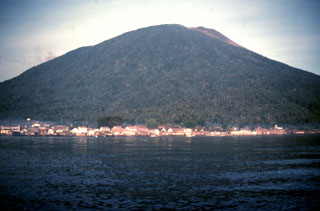Report on Gamalama (Indonesia) — July 1983
Scientific Event Alert Network Bulletin, vol. 8, no. 7 (July 1983)
Managing Editor: Lindsay McClelland.
Gamalama (Indonesia) Ash ejection; several thousand evacuated
Please cite this report as:
Global Volcanism Program, 1983. Report on Gamalama (Indonesia) (McClelland, L., ed.). Scientific Event Alert Network Bulletin, 8:7. Smithsonian Institution. https://doi.org/10.5479/si.GVP.SEAN198307-268060
Gamalama
Indonesia
0.81°N, 127.3322°E; summit elev. 1714 m
All times are local (unless otherwise noted)
AFP reported that an eruption began 9 August. Residents of villages closest to the volcano were awakened at 0445 by the activity. A thick black eruption column containing incandescent material rose 1.5 km and "red-hot lava" moved down the N flank, destroying scores of homes and plantations. Ash fell W of the volcano, closing an airport. Explosions on 10 August at about 1000 and 1200 produced 1.5-km ash columns. A wind shift threatened to cause ashfalls E of Gamalama. Earthquakes centered on the volcano accompanied the eruption.
More than 5,000 persons living near the volcano evacuated to the town of Ternate, capital of North Moluccas regency. No casualties were reported. Despite bad weather, vessels were standing by in case Ternate required evacuation.
Geological Summary. Gamalama is a near-conical stratovolcano that comprises the entire island of Ternate off the western coast of Halmahera, and is one of Indonesia's most active volcanoes. The island was a major regional center in the Portuguese and Dutch spice trade for several centuries, which contributed to the extensive documentation of activity. Three cones, progressively younger to the north, form the summit. Several maars and vents define a rift zone, parallel to the Halmahera island arc, that cuts the volcano; the S-flank Ngade maar formed after about 14,500–13,000 cal. BP (Faral et al., 2022). Eruptions, recorded frequently since the 16th century, typically originated from the summit craters, although flank eruptions have occurred in 1763, 1770, 1775, and 1962-63.
Information Contacts: AFP.

